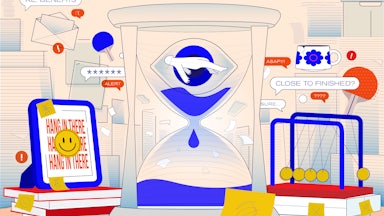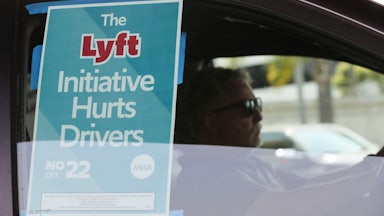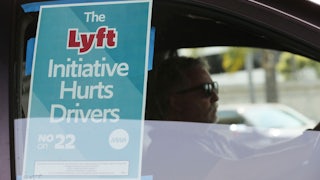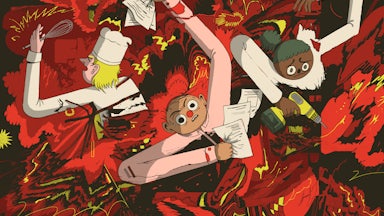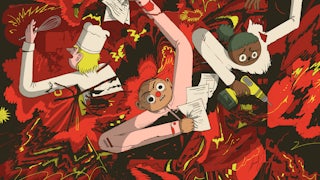One of my first bosses, the publisher of a digital media startup, sat just a few rows of desks away from me. She blended in fairly easily. The only thing that made her stick out was that her leather jacket, unlike the ones some of my co-workers wore to work, was custom made, with the words “suffering from realness” written on the back.
Work sucks on principle, but it often sucks specifically because of bosses. A 2018 poll from Monster (the job search site, not the energy drink) found that 76 percent of Americans leave their jobs because of “toxic” bosses, whom they described as power-hungry, micromanaging, incompetent, or absent. Just 19 percent of people saw their bosses as helpful mentors and advocates. And more than half of people who leave their jobs do so because of their manager, according to research from a leadership consulting firm.
My experiences with bosses over my several years working in media has been punctuated with many bad ones, to be sure. But puzzlingly, I’ve also sometimes wondered who my boss actually is. At my last job, executives’ titles changed too often to keep track; higher-ups were constantly getting promoted or switching departments. Some of them had what David Graeber called “bullshit jobs,” inessential roles that served no apparent purpose and would not be missed if they disappeared. (And they often did.) When my colleagues and I finally received the organizational chart we had requested as a union, it looked like a game of Chutes and Ladders. I knew I had an editor and a direct manager, but beyond that, it was murky and opaque, even to some of my bosses. When there was a problem to—in soul-deadening corporate parlance—“run up the ladder,” I generally couldn’t picture the person sitting at the top.
While the figure of the boss remains well defined in the cultural imagination, in reality they are increasingly hazy and indistinct. This can look different in different workplaces. In Silicon Valley, tech executives who run the multibillion-dollar companies responsible for ruining our democracy might be seen walking around the office wearing hoodies, T-shirts, and Allbirds, the industry’s unofficial-official uniform regardless of job title. Or they might not walk around the office at all but rather ride around on RipStiks, as Uncanny Valley author Anna Wiener tells us her male colleagues did when she worked in tech. Open office plans also largely did away with managers’ private offices, creating the visual effect of a sea of workers, all of whom appear equally empowered to speak and act in the workplace. These office plans coincided with companies’ attempts to implement more “horizontal” or “fluid” organizational structures, to remove the superficial symbols of hierarchy—though not the hierarchy itself.
The nonboss haunts even more conventionally structured jobs. When McDonald’s employees across the country began detailing a pervasive culture of sexual harassment in the company’s restaurants, McDonald’s claimed it wasn’t liable for personnel problems at its chains. In October 2019, a federal appeals court bolstered this claim, ruling that McDonald’s was not a “joint employer” of McDonald’s franchise workers. As of 2018, there are at least 18 states that have joint employer shields on the books, allowing franchisers that operate in those states similarly to dodge their responsibility to franchise employees, who are often food-service and hospitality workers earning minimum wage. The big boss, in these cases, is no boss at all. (President Biden has pledged to address the joint employer rule through his Labor Department.)
Beyond the bounds of the physical workplace, the gig economy has taken this idea to its logical endpoint, seemingly eliminating the figure of the boss altogether by legally classifying its workers as independent contractors. Independent contractors have no boss or are encouraged to “be their own boss,” a mantra of self-empowerment that belies the conditions under which they labor.
When bosses are kept from view, or entire industries are structured around their fictional absence, it is a feature, not a bug. Not knowing where the buck stops makes it infinitely more difficult for workers to fight for more rights and protections in the workplace, which is precisely the intention of these nebulous arrangements. Organizing requires workers to see themselves as such, and feel solidarity with other workers. But it also requires them to identify clearly who their bosses are, for reasons both psychological and material. In a bossless world, from whom do we demand these things?
This problem is most literalized for Uber and Lyft drivers, whose position as ostensibly bossless contractors was recently enshrined in California by Prop 22. The ballot measure, which passed by a wide margin last November, exempted Instacart and the two ride-share apps from categorizing workers as employees and guaranteeing them the attendant labor protections that come with that categorization. This logic naturally extends from the absurd fact that Uber and Lyft don’t view themselves as employers, but rather as platforms, turning the workers who provide the services they advertise into its “customers,” according to its 2019 filing with the Securities and Exchange Commission. (In turn, Uber’s actual customers are “end-users.”) Conveniently, the designation allows these companies to continue to deny drivers basic labor protections as well as the ability to do anything about it: Technically speaking, independent contractors don’t have the right to collectively bargain.
That hasn’t stopped them from trying. In 2019, ride-share drivers in 10 cities went on strike ahead of Uber’s IPO launch, turning off the app for hours and joining picket lines outside airports and the company’s offices to call for higher wages and caps on the commission Uber takes per ride, among other demands. The strikes were successful in many respects, foremost because they disrupted Uber’s optimistic public relations gambit with the press about the way the company mistreats—or altogether ignores—its drivers. But Uber’s refusal to play the role of boss has made it harder than usual for workers to organize, as well as legally impossible without the intervention of state and federal regulators. “I think it’s going to be left up to legislators to step in and actually say, ‘No, you have to treat your workers fairly regardless of how you classify them,’” Rebecca Stack Martinez, an Uber and Lyft driver who helped organize the San Francisco strike, told the Los Angeles Times at the time.
Cultural messaging around work tells us that this is a desirable arrangement, not having a boss. Start discussing “dream jobs,” and someone will probably encourage you to think about “working for yourself,” a supposed solution to whatever drudgery you happen to be complaining about. If you don’t have a boss, you’ll love your job, the logic goes; and if you love your job, you won’t work a day in your life.
This rhetoric has been around for decades, but it coheres well with the cult of individual empowerment and “hustle” that has shaped our current work economy, the defining feature of which is the transformation of oppressive or exploitative conditions into what appear to be appealing lifestyle choices. At first blush, having a job with no boss seems to promise the same freedom as being home for the weekend with no parents. You don’t have to answer to anyone but yourself, proselytizers for this idea might say; you can make your own hours and work from home (a novelty from another time). No commutes! No busy work! No gods! No masters! “When you’re your own boss, you have a unique chance to shape your days the way you want to,” Accion, a loan provider for small-business owners, writes in a blog about the benefits of self-employment. “You can pick and choose the work that you like and focus on what makes you smile.”
But escaping bosses does not mean escaping work or the hierarchies that usually accompany it, which replicate themselves easily. The founders of Substack, for example, have advertised their platform as a place individual writers can go to self-manage, self-edit, and self-publish without the oversight of an editor, or boss. (Like many of their peers, the executives at Substack maintain they did not create a workplace, but a platform, renouncing their responsibilities for the content on the site or the people who produce it.) But early-career writers—or just those with smaller Twitter followings—have found that the barriers they faced in the media industry remain stubbornly intact on Substack, as Clio Chang recently reported for Columbia Journalism Review. The same writers who succeeded in traditional media find success on the platform, and the ones who struggled continue to do so, learning that working for themselves often means more work for less pay and more precarity. “In a broken industry, even a little agency can start to feel like control,” Chang wrote. “But … if ‘be your own boss’ is a nice slogan in the abstract, it ignores the fact that power dynamics always exist, even where they’re not formalized.”
In case, at any point while reading this, you thought, “Did a boss write this?” let me be clear: This essay is not a defense of bosses. During the pandemic, many bosses, while not physically present, have made themselves frighteningly ubiquitous. Lacking the ability to monitor their employees at their desks in the office, they’ve found new ways to surveil workers in the remote workplace. Bosses can be toxic, micromanaging, incompetent, and sometimes violent, just as Monster’s poll participants said. Most, I would venture, have at least one of these qualities. These are the circumstances that make life without a boss appear so seductive, even as most of us can easily see through the false assurances of it in our current economic system.
But the shallow anti-boss ethos of a Substack or Uber executive couldn’t be further from actual anti-boss labor formations. Worker cooperatives eradicate the boss structurally, not just superficially: Unlike gig economy giants, which make low-wage workers shoulder the travails of their jobs alone under the guise of freedom, co-ops do away with bosses by building a workplace founded on collective decision-making and mutual accountability. In this arrangement, workers get an equal say in the terms of their labor and the protections they’re afforded. Most co-ops achieve this through an elected board of directors in which at least half the members are employees. Running a company this way can become messy, but co-ops deliver on the promises of a bossless world where other models fail.
But outside the co-op, marking bosses clearly as bosses—not family or friends, as the hoodie-wearing tech execs might have one believe; or middlemen, as Uber has dictated—is the first step in improving the conditions of our workplaces. Collective boss-loathing is often the first step in a good union campaign. Knowing who our bosses are is the prerequisite to holding them accountable, demanding better treatment, and organizing to diminish their power to intimidate or abuse workers. The future of work isn’t a society where everyone acts as their own boss in an atomized, one-person workplace but rather one where, together, workers own, operate, and manage their own businesses democratically.
Just as Silvia Federici envisioned wages for housework as a means by which eventually to refuse to perform housework altogether, forcing bosses from their newfound obscurity is a step in a similarly radical process: See the boss, weaken the boss, abolish the boss.

